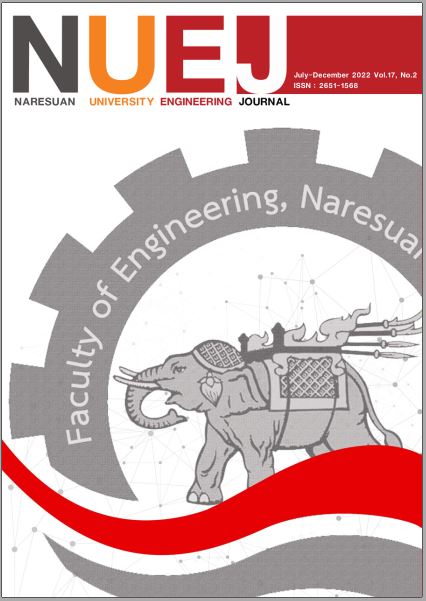Establishment of Water Quality Indexes for Raw Water in the Water Supply
Main Article Content
Abstract
Over two decades, climate variability has caused a significant change in human well-being, particularly in the availability of water resources. The water shortage and insufficient water supply especially affect the quality of life in many ways. The Pollution Control Department (PCD) of the Metropolitan Waterworks Authority (MWA) has selected thirteen parameters considered essential as indicators of raw water suitability. The water quality of the Chao Phraya River at 18 PCD stations along the 379-km stretch from Chainat to Samutprakarn has been recorded for analysis and considered for inclusion in a Water Quality Index (WQI) that includes color, turbidity, Biochemical Oxygen Demand (BOD), Dissolved oxygen (DO), pH, Nitrate-Nitrogen (NO3-N), Fe, Mn, Total Dissolved Solids (TDS), Total Phosphorous (TP), Electrical Conductivity (EC), salinity, and hardness. The WQI provides a single value for water quality suitability, is useful for the MWA in water supply production, and reflects the constituents that may be harmful to the consumer and the efficiency of production. For example, if the salinity in raw water is greater than 0.25 mg/l, the salt content of the water cannot be removed by the MWA system, resulting in a water supply with a salty flavor. Therefore, if the deteriorated water quality of raw water is predicted in advance, measured at a point upriver from the Samlae intake station, appropriate solutions can be put in place. Using PCD water quality records, the average WQI score of the Chao Phraya River in the rainy season is 74.63 and in the dry season is 78.37 (from a full score of 100). These values indicate the deterioration of raw water quality during the low flow period, a situation that the MWA should acknowledge and make periodical inspections to identify and control.
Article Details

This work is licensed under a Creative Commons Attribution-NonCommercial-NoDerivatives 4.0 International License.
References
Brown, R. M., McClelland, N.I., Deininger, R.A., & Tozer, R.Z. (1970). A water quality index-do we dare?, Water& Sewage Works. 117, 339-343.
Boyacıoğlu, H. (2009). Development of a water quality index based on a European classification scheme. Water SA, 33, 101-106. doi:https://doi.org/10.4314/WSA.V33I1.47882
Gradilla-Hernández, M. S., de Anda, J., Garcia-Gonzalez, A., Montes, C. Y., Barrios-Piña, H., Ruiz-Palomino, P., & Díaz-Vázquez, D. (2020). Assessment of the water quality of a subtropical lake using the NSF-WQI and a newly proposed ecosystem specific water quality index.
Environmental Monitoring and Assessment, 192(5),296. doi:https://www.doi.org/10.1007/s10661-020-08265-7
Horton, R. K. (1965). An index-number system for rating water quality. Journal of Water Pollution Control Federation, 37(3), 300-306.
Landwehr, J. M. (1979). A statistical view of a class of water quality indices. Water Resources Research, 15(2), 460-468. doi:https://doi.org/10.1029/WR015i002p00460
Linstone, H., & Turoff, M. (1976). The Delphi Method: Techniques and Applications. Journal of Marketing Research, 13(3), 317–318. doi:https://www.doi.org/10.2307/3150755
Meher, P., Sharma, P., Gautam, Y. P., Kumar, A., & Mishra, K. P. (2015). Evaluation of Water Quality of Ganges River Using Water Quality Index Tool. Environment Asia, 8, 124-132. doi:https://www.doi.org/10.14456/ea.2015.15
Meyer, M. A., & Booker, J. M. (1990). Eliciting and analyzing expert judgment: A practical guide. United States.
doi: https://doi.org/10.2172/5088782
Pilailar, S., & Urantinon, A. (2019). Chao Phraya River contamination sources investigation and water quality capacity in dry season evaluation. Journal of Environmental Management, 15(1), 62-83. doi:https://www.doi.org/10.14456/jem.2019.4
Prakirake, C., Chaiprasert, P., & Tripetchkul, S. (2009). Development of specific water quality index for water supply in Thailand. Songklanakarin Journal of Science and Technology, 31, 91-104.
Simachaya, W. (2000). Water quality criteria and standards of water quality in Thailand. Paper for the Workshop on “Environmentally Sound Technology on Water Quality Management” UNEP, Mekong River Commission (MRC), Bangkok. https://www.pcd.go.th/waters/%E0%B9%80%E0%B8%AD%E0%B8%81%E0%B8%AA%E0%B8%B2%E0%B8%A3-water-quality-management-in-thailand
Thamkasem, T., Chaotanont, P. & Naenna, P. (1986, January 27-29). Water quality of The Chao Phra Ya River at the MWA raw water pump station. Tambol Samlae, Amphor Muang, Pathumthani. 24th Academic Conference of Kasetsart University in Environment, Thiamkomkris Building, Faculty of Forestry, Kasetsart University, Bangkok, Part 8, 1-15.
https://kukrdb.lib.ku.ac.th/proceedings/KUCON/search_detail/dowload_digital_file/3944/7096
Tiyasha, Tung, T. M., & Yaseen, Z. M. (2020). A survey on river water quality modelling using artificial intelligence models: 2000–2020. Journal of Hydrology, 585, 124670. doi:https://doi.org/10.1016/j.jhydrol.2020.124670
Uddin, M. G., Nash, S., & Olbert, A. I. (2021). A review of water quality index models and their use for assessing surface water quality. Ecological Indicators, 122, 107218, 1-21. doi:https://doi.org/10.1016/j.ecolind.2020.107218
World Health Organization. (2011). Guidelines for Drinking-water Quality, Fourth Edition. WHO https://apps.who.int/iris/bitstream/handle/10665/44584/9789241548151_eng.pdf


